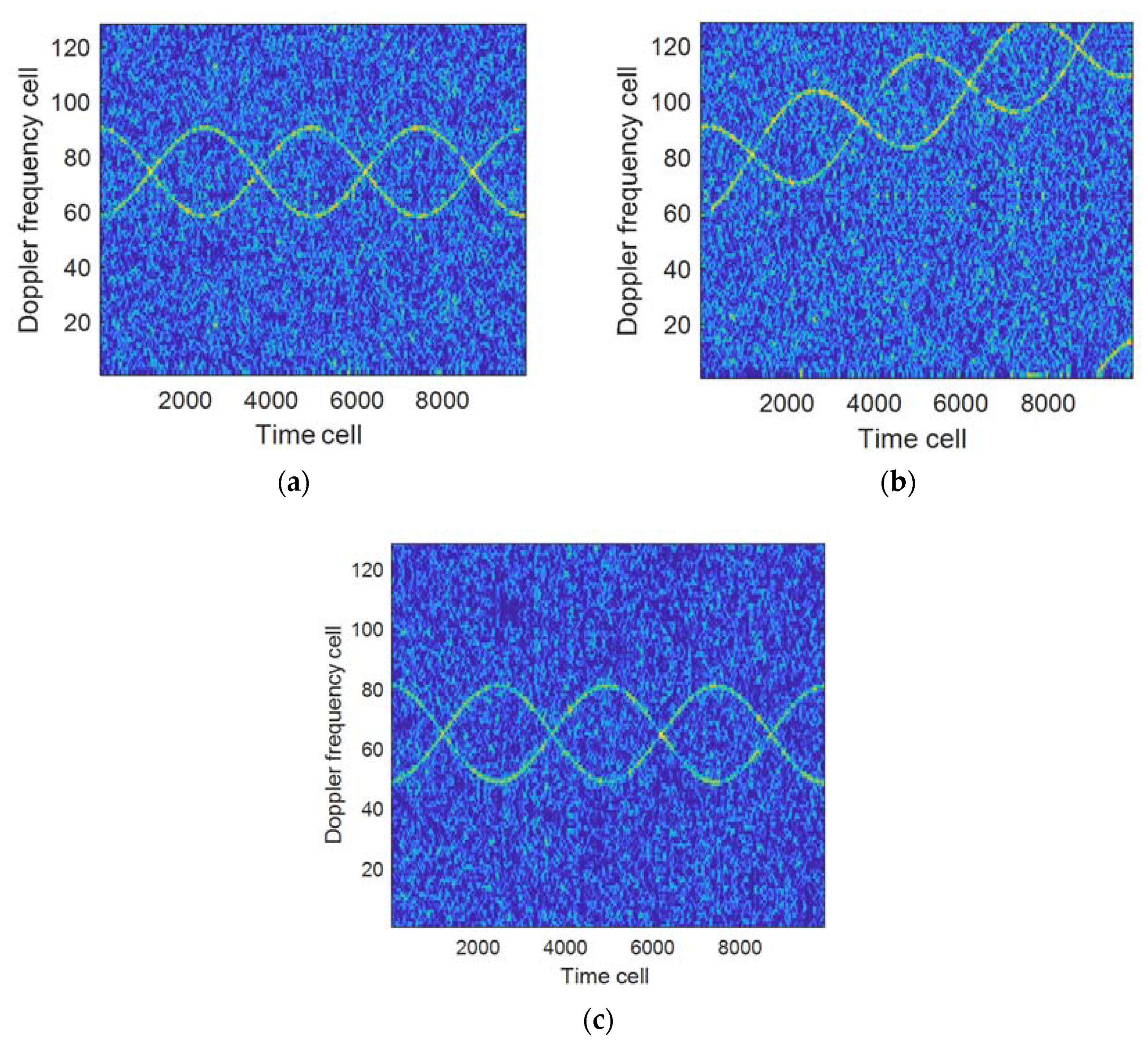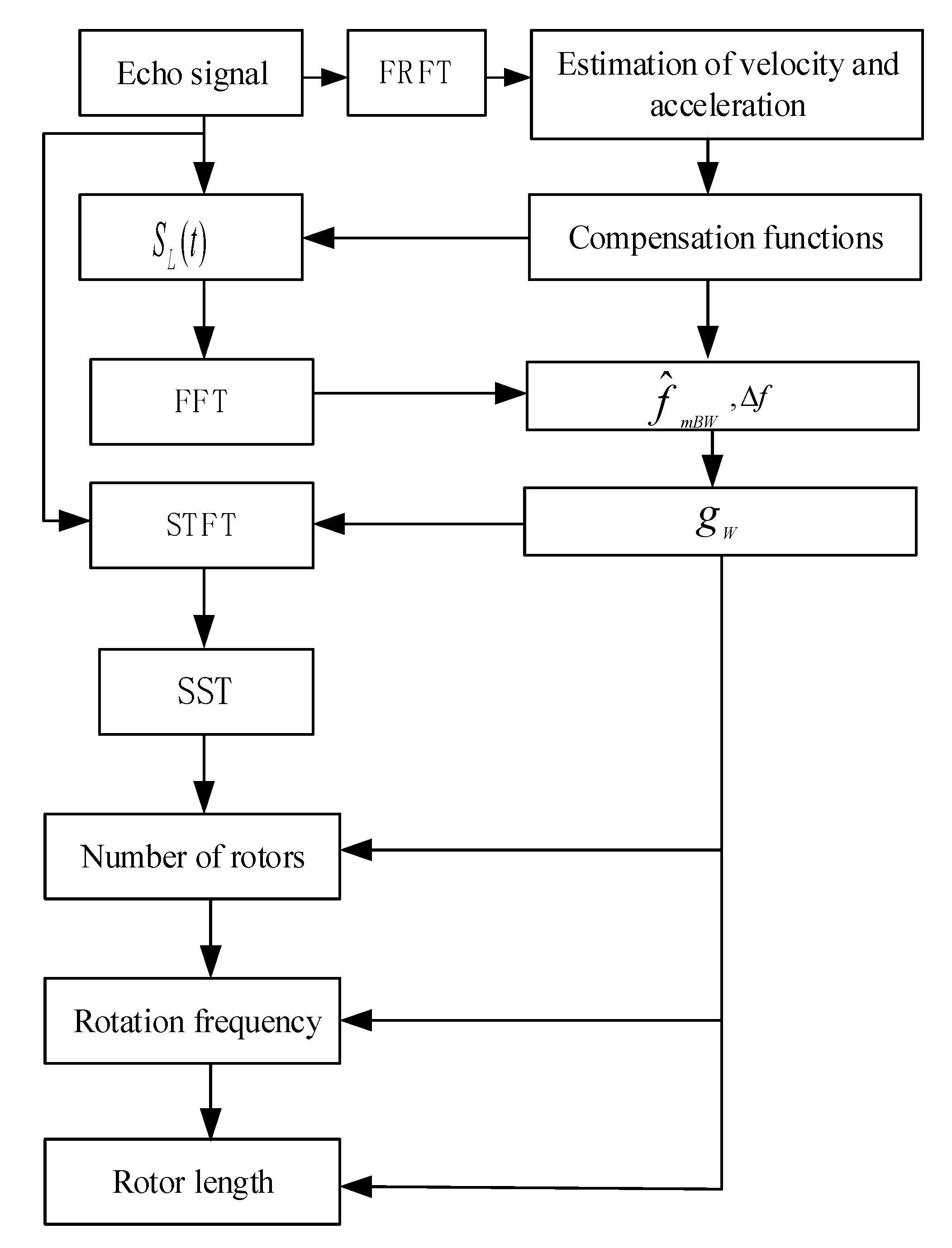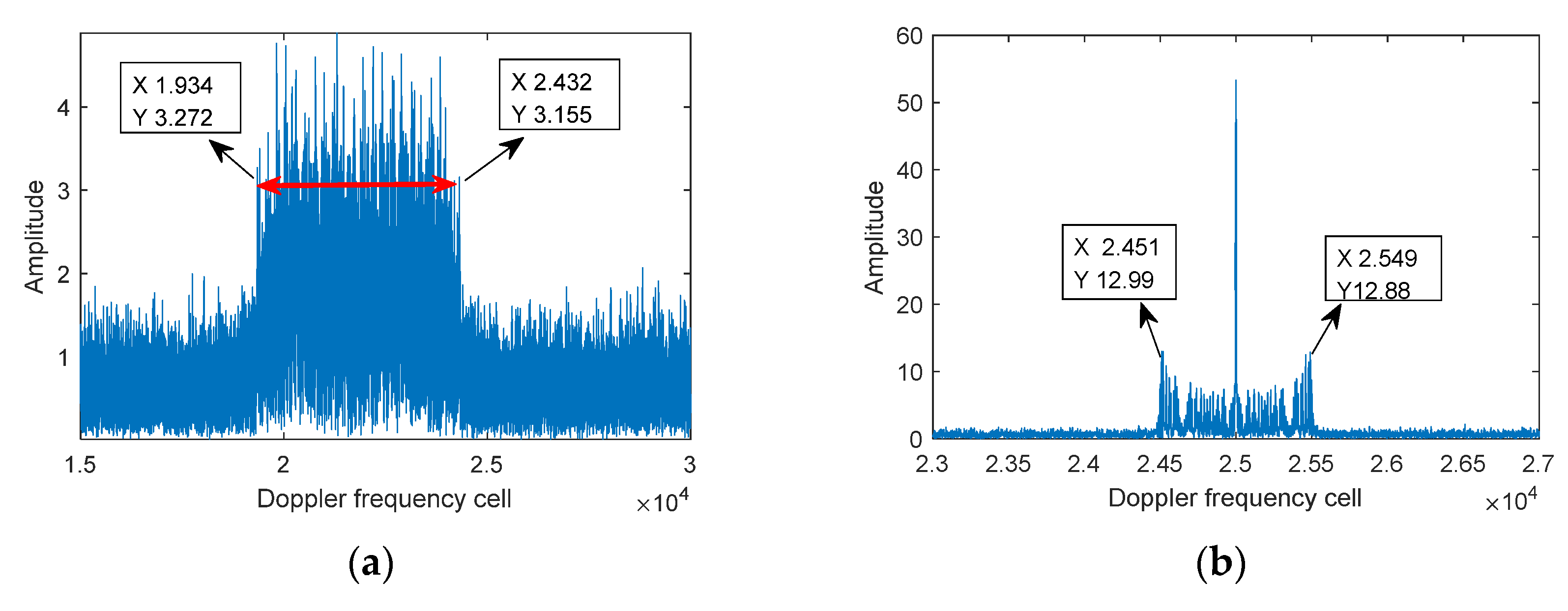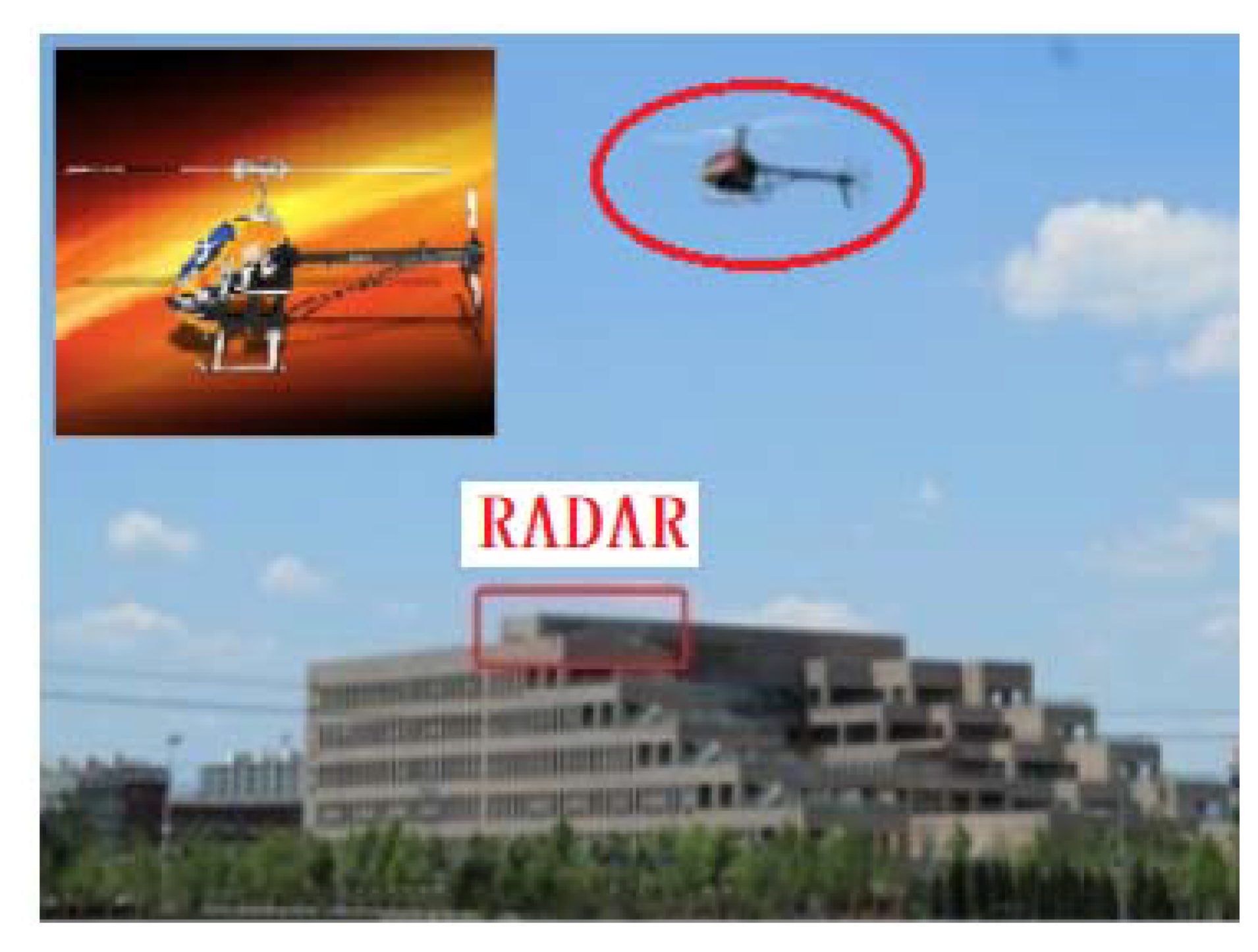Rotor UAV’s Micro-Doppler Signal Detection and Parameter Estimation Based on FRFT-FSST
Abstract
:1. Introduction
2. Echo Signal Model
2.1. Signal Model
2.2. Doppler Features of UAV
3. Micro-Doppler Signal Analysis Based on FRFT-FSST
3.1. Velocity and Acceleration Compensation Based on FRFT
3.2. Time-Frequency Analysis Based on FSST
4. Parameter Estimation
4.1. Estimation of the Number of Rotors
4.2. Estimation of Rotation Frequency
4.3. Estimation of Rotor Length
- (1)
- FRFT is performed on the echo signal to estimate the velocity and acceleration of the target, and then a penalty function is constructed to eliminate the influence of the velocity and acceleration on the time-frequency curve to obtain the function ;
- (2)
- FFT is performed on to obtain ,the interval of adjacent spectral lines, , the micro-Doppler bandwidth, and then ,the estimated window length is given;
- (3)
- is used to perform STFT and SST processing on the echo signal to obtain a high-resolution time-spectrogram;
- (4)
- According to the time-frequency time-spectrogram, Equations (24), (26), and (28) are used to estimate the number of rotors, rotation frequency, and rotor length.
5. Influence of Rotor Parameters on Time-Frequency Features
5.1. Influence of Rotor Number and Rotation Frequency on Time-Frequency Features
5.2. Influence of Time-Varying Rotation Frequency on Time-Frequency Features
6. Analysis on Algorithm Performance
6.1. Simulation Experiment
6.2. Measured Data
6.3. Analysis of Algorithm Complexity
7. Conclusions
Author Contributions
Funding
Institutional Review Board Statement
Informed Consent Statement
Data Availability Statement
Conflicts of Interest
References
- Guo, X.; Ng, C.S.; de Jong, E. Micro-Doppler based mini-UAV detection with low-cost distributed radar in dense urban Environmen. In Proceedings of the 2019 16th European Radar Conference (EuRAD), Paris, France, 2–4 October 2019; pp. 189–192. [Google Scholar]
- Aldowesh, A.; Alnuaim, T.; Alzogaiby, A. Slow-Moving Micro-UAV detection with a small scale Digital Array Radar. In Proceedings of the 2019 IEEE Radar Conference (RadarConf), Boston, MA, USA, 22–26 April 2019; pp. 1–5. [Google Scholar]
- Chen, V.C.; Li, F.; Ho, S.-S.; Wechsler, H. Analysis of micro-Doppler signatures. IEE Radar Sonar Navig. 2003, 150, 271–276. [Google Scholar] [CrossRef]
- Yang, T.; De Maio, A.; Zheng, J. An Adaptive Radar Signal Processor for UAVs Detection with Super-resolution Capabilities. IEEE Sens. J. 2021, 99, 1–10. [Google Scholar]
- Herschfelt, A.; Birtcher, C.R.; Gutierrez, R.M. Consumer-grade drone radar cross-section and micro-Doppler phenomenology. In Proceedings of the 2017 IEEE Radar Conference (RadarConf), Seattle, WA, USA, 8–12 May 2017; pp. 981–985. [Google Scholar]
- Pang, C.; Han, Y.; Hou, H.; Liu, S.; Zhang, N. Micro-Doppler signal time-frequency algorithm based on STFRFT. Sensors 2016, 16, 1559. [Google Scholar] [CrossRef]
- Jian, M.; Lu, Z.; Chen, V. Experimental study on radar micro-Doppler signatures of unmanned aerial vehicles. In Proceedings of the 2017 IEEE Radar Conference (RadarConf), Seattle, WA, USA, 8–12 May 2017; pp. 0854–0857. [Google Scholar]
- Kang, K.B.; Choi, J.H.; Cho, B.L. Analysis of Micro-Doppler Signatures of Small UAVs Based on Doppler Spectrum. IEEE Trans. Aerosp. Electron. Syst. 2021, 57, 3252–3267. [Google Scholar] [CrossRef]
- Herr, D.B.; Tahmoush, D. Data-Driven STFT for UAV Micro-Doppler Signature Analysis. In Proceedings of the 2020 IEEE International Radar Conference (RADAR), Washington, DC, USA, 28–30 April 2020; pp. 1023–1028. [Google Scholar]
- Zulkifli, S.; Balleri, A. Design and Development of K-Band FMCW Radar for Nano-Drone Detection. In Proceedings of the 2020 IEEE Radar Conference (RadarConf20), Florence, Italy, 21–25 September 2020; pp. 1–5. [Google Scholar]
- Le, H.; Doan, V.S.; Nguyen, H.H.; Huynh-The, T.; Le-Ha, K.; Hoang, V.P. Micro-Doppler-Radar-Based UAV Detection Using Inception-Residual Neural Network. In Proceedings of the 2020 International Conference on Advanced Technologies for Communications (ATC), Nha Trang, Vietnam, 8–10 October 2020; pp. 177–181. [Google Scholar]
- Chen, X.; Yu, X.; Guan, J.; Zhang, J. Detection and extraction of marine target with micromotion via short-time fractional Fourier transform in sparse domain. In Proceedings of the 2016 IEEE International Conference on Signal Processing, Communications and Computing (ICSPCC), Belfast, UK, 23–26 October 2017; pp. 1–5. [Google Scholar]
- Robey, F.C.; Fuhrmann, D.R.; Kelly, E.J.; Nitzberg, R. A CFAR adaptive matched filter detector. IEEE Trans. Aerosp. Electron. Syst. 1992, 28, 208–216. [Google Scholar] [CrossRef] [Green Version]
- Ghojavand, K.; Derakhtian, M.; Biguesh, M. Rao-Based Detectors for Adaptive Target Detection in the Presence of Signal-Dependent Interference. IEEE Trans. Signal Process. 2020, 68, 1662–1672. [Google Scholar] [CrossRef]
- Hua, X.; Ono, Y.; Peng, L. Target Detection within Nonhomogeneous Clutter via Total Bregman Divergence-Based Matrix Information Geometry Detectors. arXiv 2020, arXiv:2012.13861. [Google Scholar]
- Liu, J.; Liu, W.; Hao, C. Persymmetric Subspace Detectors With Multiple Observations in Homogeneous Environments. IEEE Trans. Aerosp. Electron. Syst. 2020, 56, 3276–3284. [Google Scholar] [CrossRef]
- Yamazaki, Y.; Premachandra, C.; Perea, C.J. Audio-processing-based Human Detection at Disaster Sites with Unmanned Aerial Vehicle. IEEE Access 2020, 99, 1. [Google Scholar] [CrossRef]
- Nakadai, K.; Kumon, M.; Okuno, H. Development of microphone-array-embedded UAV for search and rescue task. In Proceedings of the 2017 IEEE/RSJ International Conference on Intelligent Robots and Systems (IROS), Vancouver, BC, Canada, 24–28 September 2017. [Google Scholar]
- Coluccia, A.; Parisi, G.; Fascista, A. Detection and Classification of Multirotor Drones in Radar Sensor Networks: A Review. Sensors 2020, 20, 4172. [Google Scholar] [CrossRef] [PubMed]
- Huizing, A.; Heiligers, M.; Dekker, B. Deep Learning for Classification of Mini-UAVs Using Micro-Doppler Spectrograms in Cognitive Radar. IEEE Aerosp. Electron. Syst. Mag. 2019, 34, 46–56. [Google Scholar] [CrossRef]
- Sun, Y.; Abeywickrama, S.; Jayasinghe, L. Micro-Doppler Signature-Based Detection, Classification, and Localization of Small UAV With Long Short-Term Memory Neural Network. IEEE Trans. Geosci. Remote Sens. 2020, 99, 1–16. [Google Scholar] [CrossRef]
- Zhang, Y.D.; Xiang, X.; Li, Y.; Chen, G. Enhanced Micro-Doppler Feature Analysis for Drone Detection. In Proceedings of the 2021 IEEE Radar Conference (RadarConf21), Atlanta, GA, USA, 7–14 May 2021. [Google Scholar]
- Coluccia, A.; Fascista, A.; Schumann, A. Drone vs. Bird Detection: Deep Learning Algorithms and Results from a Grand Challenge. Sensors 2021, 21, 2824. [Google Scholar] [CrossRef]
- Wang, J.; Liu, Y.; Song, H. Counter-Unmanned Aircraft System(s) (C-UAS): State of the Art, Challenges, and Future Trends. IEEE Aerosp. Electron. Syst. Mag. 2021, 36, 4–29. [Google Scholar] [CrossRef]
- Ahrabian, A.; Mandic, D.P. A class of multivariate denoising algorithms based on synchrosqueezing. IEEE Trans. Signal Process. 2015, 63, 2196–2208. [Google Scholar] [CrossRef]
- Oberlin, T.; Meignen, S.; Perrier, V. Second-order synchrosqueezing transform or invertible reassignment? Towards ideal time-frequency representations. IEEE Trans. Signal Process. 2015, 63, 1335–1344. [Google Scholar] [CrossRef] [Green Version]
- Pham, D.H.; Meignen, S. High-order synchrosqueezing transform for multicomponent signals analysis With an application to gravitational wave signal. IEEE Trans. Signal Process. 2017, 65, 3168–3178. [Google Scholar] [CrossRef] [Green Version]
- Zhao, Y.; Su, Y. Synchrosqueezing Phase Analysis on Micro-Doppler Parameters for Small UAVs Identification With Multichannel Radar. IEEE Geosci. Remote Sens. Lett. 2019, 117, 411–415. [Google Scholar] [CrossRef]
- Chen, V.C. The Micro-Doppler Effect in Radar; Artech House: London, UK, 2019. [Google Scholar]
- Tao, R.; Deng, B.; Wang, Y. Research progress of the fractional Fourier transform in signal processing. Sci. China Ser. F 2016, 49, 1–25. [Google Scholar] [CrossRef]
- Robey, F.C.; Kelly, E.J. The fractional Fourier transform and time-frequency representations. IEEE Trans. Signal Process. 1994, 42, 3084–3091. [Google Scholar]
- Qi, L.; Tao, R. Detection and parameter estimation of multicomponent LFM signal based on the fractional Fourier transform. Sci. China Ser. F Inf. Sci. 2004, 47, 184–198. [Google Scholar] [CrossRef]
- Pang, C.; Liu, S.; Han, Y. Coherent detection algorithm for radar maneuvering targets based on discrete polynomial-phase transform. IEEE J. Sel. Top. Appl. Earth Obs. Remote Sens. 2019, 12, 3412–3422. [Google Scholar] [CrossRef]
- Djurović, I.; Popović-Bugarin, V.; Simeunović, M. The STFT-based estimator of micro-Doppler parameters. IEEE Trans. Aerosp. Electron. Syst. 2017, 53, 1273–1283. [Google Scholar] [CrossRef]
- Luo, Y.; Chen, Y.J.; Zhu, Y.Z. Doppler effect and micro-Doppler effect of vortex-electromagnetic-wave-based radar. IET Radar Sonar Navig. 2019, 14, 2–9. [Google Scholar] [CrossRef]
- Oberlin, T.; Meignen, S.; Perrier, V. The Fourier-based synchrosqueezing transform. In Proceedings of the 2014 IEEE International Conference on Acoustics, Speech and Signal Processing (ICASSP), Florence, Italy, 4–9 May 2014; pp. 315–319. [Google Scholar]
- Martin, J.; Mulgrew, B. Analysis of the Theoretical Radar Return Signal from Aircraft Propeller Blades. In Proceedings of the IEEE International Radar Conference, Arlington, VA, USA, 7–10 May 1990; pp. 569–572. [Google Scholar]
- Tsao, J. Reduction of sidelobe and speckle artifacts in microwave imaging: The CLEAN technique. IEEE Trans. Antennas Propag. 1988, 36, 543–556. [Google Scholar] [CrossRef]
- Deng, H. Effective CLEAN algorithms for performance-enhanced detection of binary coding radar signals. IEEE Trans. Signal Process. 2004, 52, 72–78. [Google Scholar] [CrossRef]













| Figure 4 | (Theoretical) | (Practical) | |||
|---|---|---|---|---|---|
| (a) | 2 | 2 | 2.5 KHz | 80 | 80 |
| (b) | 4 | 2 | 2.5 KHz | 80 | 80 |
| (c) | 2 | 4 | 5 KHz | 40 | 80 |
| (d) | 2 | 4 | 5 KHz | 40 | 40 |
| Figure 5 | (Theoretical) | (Practical) | ||||
|---|---|---|---|---|---|---|
| (a) | 2 | 2 | 1 Hz/s | 2.5 KHz | 80 | 80 |
| (b) | 2 | 2 | 2 Hz/s | 2.5 KHz | 80 | 80 |
| Figure 6 | (Front 2000 Points) | (Back 2000 Points) | (Practical) | |||
|---|---|---|---|---|---|---|
| (a) | 2 | 2 | 1 Hz/s | 2.5 KHz | 80 | |
| (b) | 2 | 2 | 1 Hz/s | 4.3 KHz | 46 | |
| (c) | 2 | 2 | 2 Hz/s | 2.5 KHz | 80 | |
| (d) | 2 | 2 | 2 Hz/s | 5.3 KHz | 38 |
| Radar Parameters | Carrier Frequency | Sampling Frequency | Sampling Time | ||
|---|---|---|---|---|---|
| 95 GHz | 200 KHz | 250 ms | 0° | ||
| Target parameters | Number of rotors | Rotation frequency | Rotor length | Velocity | Acceleration |
| 4 | 10 Hz/s | 10 cm | 5 m/s | 60 m/s2 |
| Radar Parameters | Carrier Frequency | Sampling Frequency | Sampling Time | ||
|---|---|---|---|---|---|
| 674 MHz | 5 KHz | 150 ms | 40~60° | ||
| Target parameters | Number of rotors | Rotation frequency | Rotor length | Velocity | Acceleration |
| 2 | 26~42 Hz/s | 700 mm | <3 m/s | <1 m/s2 |
Publisher’s Note: MDPI stays neutral with regard to jurisdictional claims in published maps and institutional affiliations. |
© 2021 by the authors. Licensee MDPI, Basel, Switzerland. This article is an open access article distributed under the terms and conditions of the Creative Commons Attribution (CC BY) license (https://creativecommons.org/licenses/by/4.0/).
Share and Cite
Hou, H.; Yang, Z.; Pang, C. Rotor UAV’s Micro-Doppler Signal Detection and Parameter Estimation Based on FRFT-FSST. Sensors 2021, 21, 7314. https://doi.org/10.3390/s21217314
Hou H, Yang Z, Pang C. Rotor UAV’s Micro-Doppler Signal Detection and Parameter Estimation Based on FRFT-FSST. Sensors. 2021; 21(21):7314. https://doi.org/10.3390/s21217314
Chicago/Turabian StyleHou, Huiling, Zhiliang Yang, and Cunsuo Pang. 2021. "Rotor UAV’s Micro-Doppler Signal Detection and Parameter Estimation Based on FRFT-FSST" Sensors 21, no. 21: 7314. https://doi.org/10.3390/s21217314
APA StyleHou, H., Yang, Z., & Pang, C. (2021). Rotor UAV’s Micro-Doppler Signal Detection and Parameter Estimation Based on FRFT-FSST. Sensors, 21(21), 7314. https://doi.org/10.3390/s21217314






